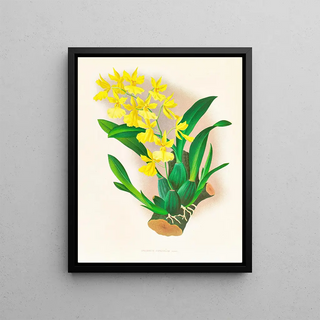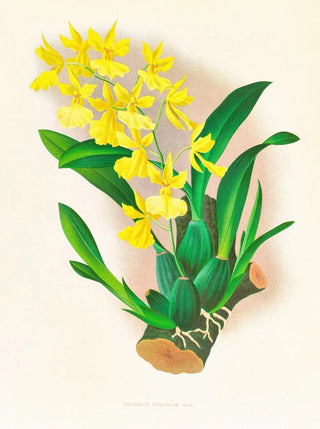Art print | Oncidium concolor - Jean Jules Linden


View from behind

Frame (optional)
Reproduction Oncidium concolor - Jean Jules Linden – Captivating introduction
The artwork "Oncidium concolor" by Jean Jules Linden is a true ode to floral beauty, capturing the very essence of nature in a vibrant and delicate composition. This painting, which evokes the grace of orchids, transports us to a world where each petal seems to vibrate under the caress of soft, warm light. Linden, a master of botanical rendering, manages to immortalize not only the shape and color of the flowers but also the emotion they evoke. The art print Oncidium concolor - Jean Jules Linden allows us to rediscover this fascinating work, while inviting us to contemplate the splendor of the intricate details that make up this living nature.
Style and uniqueness of the work
Jean Jules Linden's style is distinguished by exceptional meticulousness and a keen sense of observation. In "Oncidium concolor," each flower is painted with a precision that borders on hyperrealism, while maintaining a touch of idealization characteristic of 19th-century floral art. The color palette used by the artist is both rich and harmonious, blending vivid hues with pastel shades, creating a striking contrast that draws the eye. Delicate shadows and luminous reflections add depth to the composition, making each orchid almost tangible. Linden succeeds in establishing a dialogue between the subject and the surrounding space, inviting the viewer to immerse themselves in this floral scene. This painting transcends a simple portrait of flowers to become a celebration of life and the ephemeral beauty of nature.
The artist and his influence
Jean Jules Linden, born in 1817 in Brussels, is an artist whose work marked his era through his commitment to botanical representation. Passionate about natural sciences, he dedicated a large part of his career to the study and depiction of exotic plants. His work was influenced by 19th-century botanical explorations, a period when curiosity about tropical flora was at its peak. Linden skillfully combined his love for nature with a sharp artistic sense, which allowed him to carve out a prominent place among the artists of his time. His works, often presented

Matte finish

View from behind

Frame (optional)
Reproduction Oncidium concolor - Jean Jules Linden – Captivating introduction
The artwork "Oncidium concolor" by Jean Jules Linden is a true ode to floral beauty, capturing the very essence of nature in a vibrant and delicate composition. This painting, which evokes the grace of orchids, transports us to a world where each petal seems to vibrate under the caress of soft, warm light. Linden, a master of botanical rendering, manages to immortalize not only the shape and color of the flowers but also the emotion they evoke. The art print Oncidium concolor - Jean Jules Linden allows us to rediscover this fascinating work, while inviting us to contemplate the splendor of the intricate details that make up this living nature.
Style and uniqueness of the work
Jean Jules Linden's style is distinguished by exceptional meticulousness and a keen sense of observation. In "Oncidium concolor," each flower is painted with a precision that borders on hyperrealism, while maintaining a touch of idealization characteristic of 19th-century floral art. The color palette used by the artist is both rich and harmonious, blending vivid hues with pastel shades, creating a striking contrast that draws the eye. Delicate shadows and luminous reflections add depth to the composition, making each orchid almost tangible. Linden succeeds in establishing a dialogue between the subject and the surrounding space, inviting the viewer to immerse themselves in this floral scene. This painting transcends a simple portrait of flowers to become a celebration of life and the ephemeral beauty of nature.
The artist and his influence
Jean Jules Linden, born in 1817 in Brussels, is an artist whose work marked his era through his commitment to botanical representation. Passionate about natural sciences, he dedicated a large part of his career to the study and depiction of exotic plants. His work was influenced by 19th-century botanical explorations, a period when curiosity about tropical flora was at its peak. Linden skillfully combined his love for nature with a sharp artistic sense, which allowed him to carve out a prominent place among the artists of his time. His works, often presented






